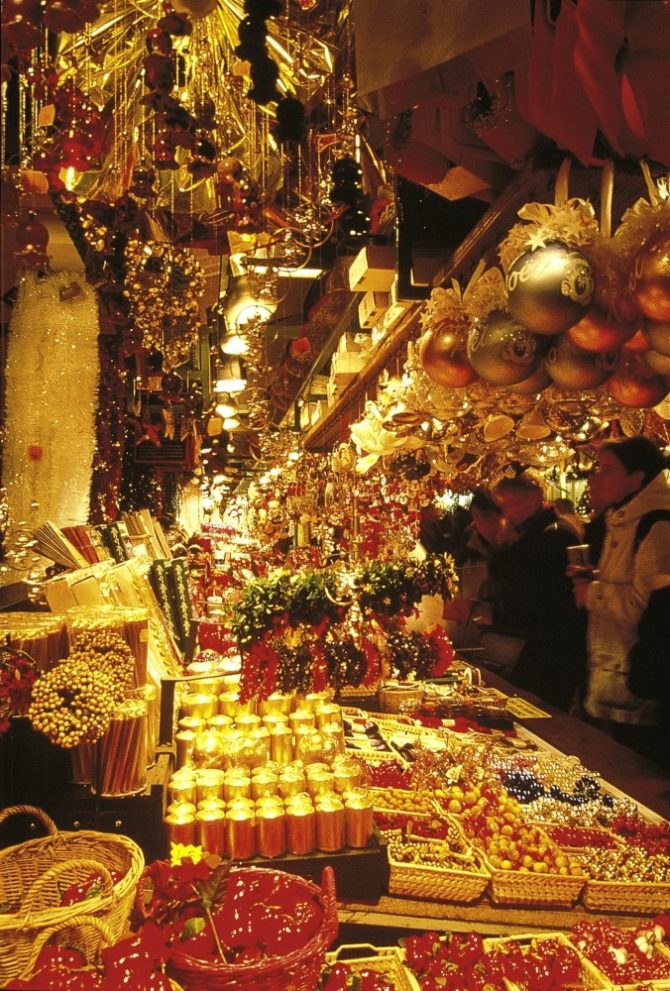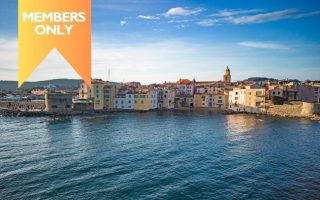All Aboard: Getaway Train to Alsace and Lorraine

It’s so easy. For a quick weekend excursion from Paris and a delightful dip into Alsace and Lorraine, with an optional stop for a sip of Champagne, just hop on a train.
Most Americans don’t automatically think about train travel, but within France it’s by far the fastest, easiest and most comfortable way to go. With the ever-expanding high-speed TGV network and a complementary system of local, regional and national Corail and TER trains, virtually the entire country is within easy reach by riding the rails. There’s no airport hassle, no long lines or security checks, no need to be at the station more than a reasonable 10 or 15 minutes before train time. You never have to take off your shoes. Your luggage stays right with you. There are no traffic jams, no highway fatigue and no terrifying encounters with French drivers. And if you want a car for back roads exploring, you can rent one at your destination station.
From Paris, all trains heading for eastern France leave from the Gare de l’Est, including the newest link in the high-speed system, the TGV Est. The route to Strasbourg goes right through Champagne country, so for an impromptu champagne lunch, it’s first stop Reims—144 kms, 90 miles, 45 minutes—as close to teleportation as currently possible.
If you’ve got the time and want to splurge, there’s the glamorous possibility of the Château de Crayères, for a full-fledged feast whipped up by chef Philippe Mille, or a slightly more down to earth regional cuisine in the Brasserie Le Jardin in the garden. For a shorter stop and simpler fare, the time-honored traditional brasserie Le Boulingrin is just a few blocks from the train station. If you’re traveling light you don’t even have to take a taxi, just wheel your weekend bag straight out of the station to the Avenue Foch and head left until you reach the Porte de Mars, the ancient Roman arches that were once integrated into the city’s medieval walls. Turn right into the Rue de Mars and Le Boulingrin, with its inviting stand of fresh oysters and shellfish out front. Or try Au Petit Comptoir, right across the street, for slightly more upmarket cuisine. Both serve champagne by the glass (une coupe, not un verre) and Au Petit Comptoir offers carafes. Depending on your schedule, of course, you might choose a longer stay in Reims, to visit the magnificent cathedral, where the kings of France were crowned for seven centuries, tour a champagne cellar or two and do a little dégustation.
From Reims to Nancy, taking the TGV can become a little complicated. A much better bet is the regional TER train from central Reims to central Nancy—no reservations needed, and it’s only an hour longer.
There are many reasons to visit Nancy, but foremost among them is the Place Stanislas, one of the most beautiful public squares in Europe. Majestic, elegant, joyous, a feast of classic architecture and gilded wrought-iron gates, it’s the effervescent center of the city’s life. Its five ornate pavilions house the Hôtel de Ville (City Hall), the Opera House, the Musée des Beaux-Arts, the palatial Grand Hôtel, and several restaurants and outdoor-terrace cafés, including the Grand Café Foy, an ornate old favorite that’s an irresistible choice for a meal. The Place comes by its regal bearing directly, built in the mid-18th century by Stanislas Leszczynski, the exiled king of Poland, father-in-law and political ally of Louis XV.
So many French cities had their origins in the Gallo-Roman era that Nancy seems a brash upstart by comparison, founded on the banks of the Meurthe River in the 11th century as the seat of the dukes of Lorraine, whose 14th-century château in the Vieille Ville now houses the Musée Historique Lorrain, with its surprisingly rich collection of archeological treasures and folk arts, as well as a rare handful of paintings by 17th-century Lorrain master Georges de la Tour. The museum extends into the adjacent church and convent of the Cordeliers, just a short walk from the turreted Porte de la Craffe, the last vestige of the city’s medieval ramparts—all built during the long reign of the dukes.
But the city really came into its own with the arrival of Stanislas, installed as the ruler of Lorraine by Louis XV as a prelude to annexing the duchy to France. Known as Good King Stanislas and filled with the ideas of the Enlightenment, he won over his subjects by building and beautifying his domain, establishing free education and free medical care. Notes the Michelin guide, “he loved good food and pretty women, and practiced an easygoing philosophy and an indulgent religion.”
Nancy enjoyed another golden era at the end of the 19th century, with the sudden, expansive blossoming of Art Nouveau and the Ecole de Nancy, which sought to bring art into everyday life with furniture, glassware, ceramics, ironwork and jewelry. The Musée de l’Ecole de Nancy, in a former Art Nouveau private home with a big, old-fashioned garden in an outlying residential district, is filled with the works of the movement’s leaders, all native sons of Nancy and the surrounding region: Emile Gallé, Auguste Daum, Louis Majorelle, Eugène Vallin, Victor Prouvé and Jacques Gruber. Everything is beautiful here, especially the stained glass windows and the rooms full of sinuous, sensuous, polished-wood marquetry furniture. The museum is unique, and a must on any visit. It’s too far from the central district to walk, though, so take a taxi, or the tram, which will get you at least within walking distance.
The city’s sleek new tramway has only one line so far, but it goes directly from train station to the cathedral, only a block from the Place Stanislas, and it stops right in front of possibly the best small hotel in town, the Hôtel des Prélats, in a 17th-century cardinals’ residence attached to the cathedral’s flank.
Before leaving town, drop in to the scrumptious Maison des Soeurs Macarons, founded in 1793, to sample two of the city’s renowned sweets—flat chewy macarons, made from a secret recipe created by 18th-century Benedictine nuns, and the traditional square hard candies called bergamotes de Nancy. Pack a snack box for the train.
A whirlwind weekend is only long enough to whet the appetite for a more substantial stay in Strasbourg, capital of Alsace, repository of history and art, gourmet lodestar and, with its immaculate half-timbered houses and sparkling waterways, one of the prettiest big cities anywhere.
At the crossroads of Germany and Gaul, the original Celtic village that became Strasbourg grew up around a Roman military camp during the 1st century AD. Its strategic position along the Rhine made it an inevitable target for invasion, and over the long course of history it has been attacked, pillaged, destroyed and rebuilt countless times. In recent history, along with the rest of Alsace it changed hands between Germany and France three times. Today, a symbol of unity, it is the home of the Council of Europe and seat of the European Parliament.
The center city is an island formed by two branches of the river Ill, a Rhine tributary. At its core, the amazing rose-colored Notre Dame Cathedral rises abruptly from the cramped medieval streets that surround it, its single lacy Gothic spire soaring above the rooftops. Both the facade and the interior are rich with carving and ornamentation, notably the flamboyant Gothic pulpit, the Pillar of the Angels and the famed astronomical clock, a 16th-century marvel with dozens of automated figures that strike the hours and rotate in procession. (There’s a special viewing of the clock’s burst of activity at 12:30 daily, but it’s really not worth the ticket price or the long wait standing in a packed throng.)
With limited time, the most important museum to see is the splendid Musée de l’Oeuvre Notre Dame, beside the cathedral in a small group of buildings dating to the 14th, 16th and 17th centuries, grouped around small courtyards and a tiny medieval garden. One of the great unsung museums of France, its collection of Alsatian medieval and Renaissance art is stunning.
For lunch, wander slowly to La Petite France, an enclave of half-timbered houses, cafés and restaurants lining small “canals” that are narrow arms of the Ill, punctuated by a bridge with three massive square towers, all that remain of the city’s 14th-century fortifications. From there, cross the river to the Musée d’Art Moderne et Contemporain, a sprawling glass-walled new museum of European art from the 1850s to the 1950s.
There’s a sleek, silent new tramway here too, that will get you back to the center of town. With extra time, there are excellent museums of Beaux-Arts, Decorative Arts and Archaeology, all in the monumental Palais Rohan. But leave enough leisure to stroll through the streets and shops of the Old Town, and then have dinner at a traditional old winstub like the family-run perennial favorite Zuem Strissel, just a short walk from the cathedral.
A whirlwind excursion to Nancy and Strasbourg is a treat any time, but December is best of all—during the Christmas season both cities are doubly enchanting, strung with garlands of lights and bursting with holiday activity late into the cold crisp nights. In Nancy, Le Village de Noël spreads out for blocks from the Place Maginot near the railroad station, where there is a special section reserved for the handmade work of artisans. In Strasbourg the Christkindelsmärik, or Christ Child market, founded in 1570, fills Cathedral Square and spills over into the nearby streets, and a second section in the Place Broglie, just as large and lively, surrounds a big stand of Christmas trees for sale. In both cities the markets are crowded with brightly lit stalls offering everything imaginable to put on the Christmas tree, around it or under it—ornaments, wreaths, mistletoe, stockings, Santas and snowmen, candles, toys, stuffed animals, puppets and marionettes, glassware, pottery, linens, crèches and figurines. There’s also sustenance for shoppers, with stands selling sausages and cheeses, pretzels, roasted chestnuts, cookies, candies and frosted gingerbread men, ladies, trees, houses, hearts—and the spicy aroma of hot mulled wine wafts on the frosty air.
Where to Stay
Hôtel des Prélats 56 pl Monseigneur Ruch, Nancy. 03.83.30.20.20. website
Hôtel Cathédrale 12-13 pl de la Cathédrale, Strasbourg. 03.88.22.12.12. website
Hôtel Cardinal de Rohan 17 rue du Maroquin, Strasbourg. 03.88.32.85.11. website
Restaurants
Château les Crayères 64 blvd Henry Vasnier, Reims 03.26.24.90.00. website
Le Boulingrin 48 rue de Mars, Reims. 03.26.40.96.22. website
Au Petit Comptoir 17 rue de Mars, Reims. 03.26.40.58.58. website
Grand Café Foy 1 pl Stanislas, Nancy. 03.83.32.15.97. website
Zuem Strissel 5 pl de la Grande Boucherie, Strasbourg. 03.88.32.14.73. website
Train travel to Reims, Nancy and Strasbourg—and countless other train excursions throughout France—are easy to arrange through Rail Europe Inc. A wide choice of flexible France Rail Passes is available, and seat reservations can be made in advance before leaving the US. 1-800-622-8600. website
Originally published in the December 2009 issue of France Today; updated in December 2012
Share to: Facebook Twitter LinkedIn Email



